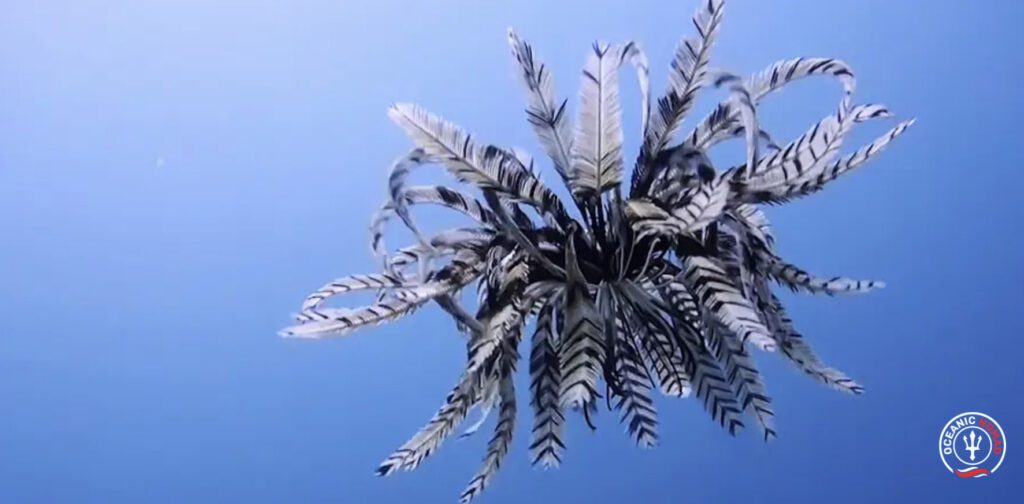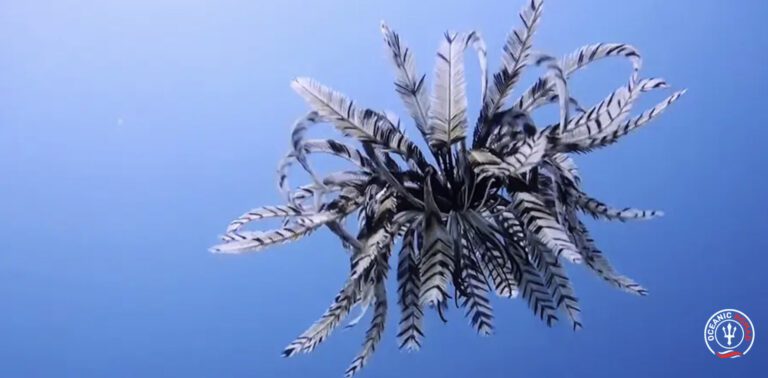Introduction
The Astonishing World of Swimming Feather Stars and Other Strange Ocean Creatures draws many readers with its promise of both the weird and the wonderful. The ocean never ceases to amaze us with its extraordinary inhabitants. Among these strange ocean creatures, one of the most captivating and peculiar is the feather star, known for its graceful and seemingly surreal ability to swim through the ocean depths. In this article, we will delve into the intriguing world of feather star swimming, explore the unique features that make these creatures so remarkable, and introduce you to other strange ocean creatures of the deep.
The Feather Star: A Mysterious Wonder of the Deep
Feather stars, scientifically known as Crinoidea, are a mesmerising group of marine animals that belong to the phylum Echinodermata. They are distant relatives of sea stars, sea urchins, and sea cucumbers, yet they possess a distinctly different lifestyle and appearance. These Strange Ocean Creatures are often likened to underwater flowers due to their feathery, delicate arms, which resemble the petals of a flower in full bloom.
Feather stars are primarily found in the world’s oceans, inhabiting both shallow and deep-sea environments. Their exquisite beauty is not only limited to their appearance but also extends to their unique method of locomotion – swimming. Unlike their sessile relatives, such as sea lilies, feather stars have evolved the ability to move about freely, making them one of the few echinoderms capable of swimming.
Feather Star Anatomy: A Delicate Elegance
Before we delve into the mesmerising world of feather star swimming, let’s take a moment to appreciate the intricate anatomy of these marine wonders.

1. Feathery Arms: The most distinctive feature of this Strange Ocean Creatures is their feathery arms, which can number from five to over two hundred, depending on the species. These arms are lined with tiny, hair-like structures called pinnules, which are used for both feeding and propulsion.
2. Calyx: The central body structure of a feather star is known as the calyx, which serves as its hub. The calyx contains vital organs such as the digestive system, reproductive organs, and this strange ocean creature’s mouth.
3. Stalk: Feather stars are attached to the substrate by a flexible stalk, which can vary in length. This stalk anchors them to the seafloor or other substrates, providing stability when they are not swimming.
4. Cirri: Protruding from the calyx are numerous long, slender appendages known as cirri. These cirri are essential for the delicate process of feather star locomotion.
Feather Star Swimming: An Astonishing Ballet
Feather stars are renowned for their ethereal swimming abilities, which seem almost otherworldly. This unique mode of locomotion sets them apart from their sedentary cousins and many other marine creatures. To fully appreciate the wonder of feather star swimming, let’s delve into the mesmerizing mechanics behind their graceful ballet in the ocean depths.
1. Ciliary Action: Feather stars propel themselves through the water using a mesmerizing combination of ciliary action and synchronized arm movements. Thousands of tiny, hair-like structures called cilia cover their pinnules. These cilia create water currents that flow towards the central calyx, generating thrust.
2. Arm Coordination: The secret to feather star swimming lies in the coordination of their multiple arms. In a harmonious choreography, these arms rhythmically extend, unfurl, and retract, creating a continuous and controlled swimming motion. Imagine a delicate ballet performance in the depths of the ocean.
3. Directional Control: Feather stars exhibit an astonishing ability to control their direction while swimming. By subtly adjusting the angle and movement of their arms, they can change course and navigate through the water with impressive precision.
4. Speed Variability: Depending on their needs and environmental conditions, feather stars can vary their swimming speed. When faced with a potential threat or seeking to conserve energy, they can slow down or even come to a graceful stop.
5. Feeding While Swimming: Feather stars are opportunistic filter feeders. They use their pinnules to capture tiny planktonic organisms from the water. Even while swimming, they can filter-feed, further showcasing their exceptional adaptation to life in the ocean.
Feather Star Species: Diversity in Motion
The world of feather stars is a diverse and captivating one, with over 600 known species inhabiting oceans worldwide. Each species exhibits its own unique adaptations and behaviours, adding to the intrigue of these marine creatures. Here are a few noteworthy feather star species:
1. Comatulids: These are the most well-known feather stars, often seen in shallow waters. Comatulids have numerous arms and are renowned for their intricate and mesmerizing swimming displays.
2. Antedonids: These deep-sea feather stars are adapted to life in the profound darkness of the ocean’s depths. They possess long and delicate arms and can swim gracefully through the cold, abyssal waters.
3. Bathycrinids: Bathycrinids are another deep-sea species, known for their unique appearance. They have a short stalk and a relatively large calyx, giving them an unusual and distinct appearance among feather stars.
Other Strange Ocean Creatures
While feather stars certainly top the list of strange ocean creatures, the depths of the sea are home to a myriad of other enigmatic beings that continue to baffle scientists and captivate the imagination of marine enthusiasts.
1. Giant Squid: The elusive giant squid, Architeuthis dux, is a colossal deep-sea creature that has fascinated scientists and storytellers alike. With eyes the size of basketballs and tentacles lined with suckers, the giant squid is a true deep-sea mystery. National Geographic has a specialist article on giant squid available here
2. Vampire Squid: Named for its dark, cloak-like appearance, the vampire squid, Vampyroteuthis infernalis, is an enigmatic cephalopod that resides in the deep sea. It possesses a unique defence mechanism known as “ink webbing.”
3. Anglerfish: The anglerfish is a bizarre denizen of the deep, characterized by its bioluminescent lure that dangles above its mouth. These creatures exhibit extreme sexual dimorphism, where males are tiny and parasitic, attaching themselves to females for reproduction.
4. Blob fish: The blob fish, Psychrolutes marcidus, is often touted as one of the world’s ugliest creatures due to its gelatinous appearance. It resides in the depths of the ocean, where the pressure is hundreds of times greater than at the surface.
Conclusion
Feather stars and their mesmerising swimming abilities are a testament to the diverse and wondrous world that lies beneath the ocean’s surface. These strange ocean creatures remind us of the incredible adaptations and behaviours that have evolved in response to the unique challenges of life in the deep sea. As we continue to explore the depths of our oceans, we are certain to encounter even more strange and remarkable inhabitants, each adding to our understanding of the astonishing diversity of life on Earth. So, the next time you gaze out at the vast expanse of the ocean, remember that beneath the waves, a world of mystery and beauty awaits, where even the most unusual creatures can dance gracefully through the deep.
Be sure to check out the Oceanic Nomad Store
Up Next
Terrifying Moment Orcas Attack Sailing Boat
10 Fascinating Seahorse Species and Where to Find Them



